Morphology transition engineering on MgO for enhanced dye adsorption without using surfactants as sacrifice templates
IF 15.8
1区 材料科学
Q1 METALLURGY & METALLURGICAL ENGINEERING
引用次数: 0
Abstract
Hierarchical porous MgO is a promising adsorbent for dye removal because of its large Brunauer–Emmett–Teller specific surface area (SBET) and abundant low-coordinated oxygen anions (LCO) sites. As hierarchical porous MgO particles with large SBET values are typically prepared by complicated procedures under harsh conditions, such as high temperatures and high pressures, their large-scale production is impractical. Consequently, the preparation of hierarchical porous MgO with a large SBET value under mild conditions is highly desirable. In this study, a morphology transition engineering strategy is introduced to change the morphology of simple MgO microspheres to an embroidered ball-shaped with a larger SBET value via hydrolysis and calcination without using surfactants as sacrificial templates. During hydrolysis, numerous Mg(OH)2 sheets form and attach to the MgO surface, thus increasing the SBET value of the newly obtained MgO that forms by calcination (denoted as NM-x, where x is the hydrolysis time in hours). The sizes of the crystalline sheets were tuned by controlling the hydrolysis time. NM-12 exhibited the highest density of small-sized sheets on its surface and the largest SBET value of 180.17 m2 g−1, which was 3.51 times that of the MgO precursor (51.89 m2 g−1). However, NM-24 (134.07 m2 g−1) had a higher adsorption efficiency for Congo red (CR) than NM-12, despite having a smaller SBET value, which indicates that other factors are involved. NM-24 exhibited a lower probability of exposed (200) and (220) facets which were verified to repulse CR molecules by molecular dynamics simulations, and a greater number of LCO sites, which contributed to adsorption. Thus, this study introduces a facile method for preparing hierarchical porous MgO and examines the effects of LCO sites and exposed facet probabilities on its adsorption properties.

不使用表面活性剂作为牺牲模板的氧化镁形态转变工程增强染料吸附
分层多孔MgO具有较大的比表面积(SBET)和丰富的低配位氧阴离子(LCO)位点,是一种很有前途的染料去除吸附剂。由于具有大SBET值的分层多孔MgO颗粒通常在高温高压等恶劣条件下通过复杂的工艺制备,因此其大规模生产是不切实际的。因此,在温和的条件下制备具有大SBET值的分层多孔MgO是非常理想的。本研究引入形态转变工程策略,在不使用表面活性剂作为牺牲模板的情况下,通过水解和煅烧将简单MgO微球的形态改变为具有较大SBET值的绣花球状。在水解过程中,大量的Mg(OH)2薄片形成并附着在MgO表面,从而增加了煅烧形成的新获得的MgO的SBET值(记为NM-x,其中x为水解时间,单位为小时)。通过控制水解时间来调整晶片的大小。NM-12表面的小尺寸薄片密度最高,SBET值为180.17 m2 g−1,是MgO前驱体(51.89 m2 g−1)的3.51倍。然而,NM-24 (134.07 m2 g−1)对刚果红(CR)的吸附效率高于NM-12,尽管其SBET值较小,这表明有其他因素参与其中。NM-24具有较低的暴露(200)和(220)面(通过分子动力学模拟验证可以排斥CR分子)的概率,并且具有较多的LCO位点(有助于吸附)。因此,本研究介绍了一种制备分层多孔MgO的简便方法,并研究了LCO位点和暴露面概率对其吸附性能的影响。
本文章由计算机程序翻译,如有差异,请以英文原文为准。
求助全文
约1分钟内获得全文
求助全文
来源期刊

Journal of Magnesium and Alloys
Engineering-Mechanics of Materials
CiteScore
20.20
自引率
14.80%
发文量
52
审稿时长
59 days
期刊介绍:
The Journal of Magnesium and Alloys serves as a global platform for both theoretical and experimental studies in magnesium science and engineering. It welcomes submissions investigating various scientific and engineering factors impacting the metallurgy, processing, microstructure, properties, and applications of magnesium and alloys. The journal covers all aspects of magnesium and alloy research, including raw materials, alloy casting, extrusion and deformation, corrosion and surface treatment, joining and machining, simulation and modeling, microstructure evolution and mechanical properties, new alloy development, magnesium-based composites, bio-materials and energy materials, applications, and recycling.
 求助内容:
求助内容: 应助结果提醒方式:
应助结果提醒方式:


